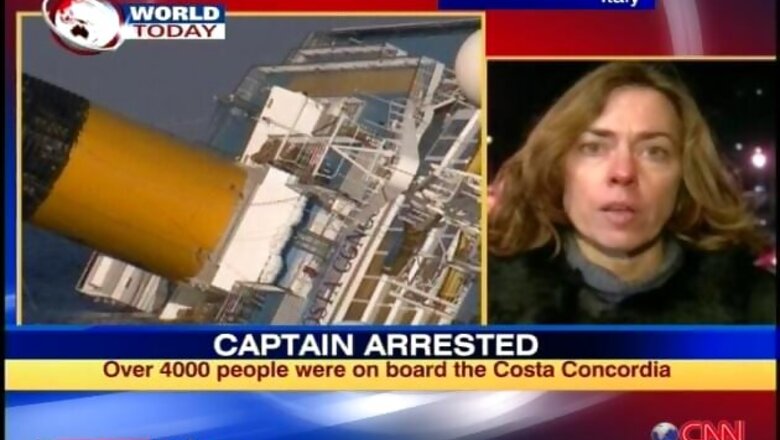
views
Porto Santo Stefano: About 40 people were still missing Sunday more than 24 hours after an Italian cruise ship with more than 4,000 on board capsized off Italy's west coast, killing at least three people and injuring 70.
The captain of the luxury 114,500-tonne Costa Concordia was being held in jail accused of multiple manslaughter, causing a shipwreck and abandoning ship, Italian police said.
Passengers, some saying it felt like a rerun of the Titanic disaster, told of people leaping into the sea and fighting over lifejackets in panic when the ship hit a rock and ran aground near the island of Giglio late Friday.
"I was sure I was going to die. We were in the lifeboats for two hours, crying and holding on to each other," said Antonietta Sintolli, 65, breaking down in tears as she recounted the event.
"People were trying to steal lifejackets from each other. We could only gets ones for children."
Passengers said mainly Asian crew members, few of them able to speak Italian, struggled to bring order to the evacuation.
Early Sunday, firefighters found two people still alive in a cabin after making voice contact with them from several decks above, Italian media reported.
An official involved in the rescue operation said two French tourists and a Peruvian crew member were dead.
There were fears the death toll could rise in one of Italy's worst shipping disasters in years as specialist diving teams checked interior spaces of the vessel.
"We don't rule out the possibility that more people will be lost," said fire services spokesman Luca Cari. It was not clear how many of those unaccounted for could still be trapped in the ship or simply had not been counted among those rescued.
The ship's captain, Francesco Schettino, was arrested on Saturday night for questioning by magistrates, police said.
They said Schettino, whose ship was carrying 4,229 passengers and crew, abandoned the vessel before all the passengers were taken off.
The vessel's operator, Costa Crociere, a unit of Carnival Corp & Plc, the world's largest cruise company, said the Costa Concordia had been sailing on its regular course when it struck a submerged rock.
In a television interview, Schettino said the rock was not marked on any maritime charts of the area.
Costa Cruises president Gianni Ororato said the captain "performed a maneuver intended to protect both guests and crew" but it was "complicated by a sudden tilting of the ship."
It remained unclear how the 290-metre long ship had run aground in calm waters so close to the shore.
"We'll be able to say at the end of the investigation. It would be premature to speculate on this," said coastguard spokesman Filippo Marini.
The ship was involved in an accident on November 22, 2008 when it hit a port wall and was damaged while docking.
In the latest incident the Costa Concordia was left capsized on its side in water 15-20 meters deep, with decks partly submerged, not far from the shore. A large gash was visible on its side.
Local officials expressed concern that the fuel on the ship, at full load as it had just begun the cruise, could spill into the pristine waters.
Passengers had just sat down to dinner, a few hours after leaving the port of Civitavecchia near Rome on a week-long cruise to Barcelona and Majorca, when a loud bang interrupted the piano player and the ship began to list.
"We heard a loud rumble, the glasses and plates fell from the tables, the ship tilted and the lights went off," said passenger Luciano Castro.
"What followed was scenes of panic, people screaming, running around the place. Close to us a five-month pregnant young woman was crying and panicking."
The ship, a vast floating resort with spas, theatres, swimming pools, a casino and discotheque, was carrying mainly Italian passengers, but also many foreigners including British, Germans, French, Spanish and Americans.
Many were elderly and some were in wheelchairs.
"It was complete panic. People were behaving like animals. We had to wait too long in the lifeboats," said 47-year-old Patrizia Perilli.
It also became more difficult for the lifeboats to be lowered the more the ship listed.
"We thought we wouldn't make it. I saw the lighthouse but I knew I couldn't swim that far but lots of people threw themselves into the sea. I think they are some of the dead."
Angel Holgado, 50, a guitarist who had been performing when the ship foundered, said he got into a lifeboat but decided to abandon it after it became dangerously overcrowded.
"There was terrible panic and fear and I jumped into the water and swam to the shore," he said.
After a night-time operation involving helicopters, ships and lifeboats, the picturesque harbor of Porto Santo Stefano was lined with ambulances and green tents for the victims.
Passengers said they had been given little or no information in the immediate aftermath of the ship running aground.
"After approximately 20 minutes a voice told us there was a problem with the electricity that they were trying to fix," said Luciano Castro.
"The ship continued to tilt further, after 15 minutes they said again it was a problem with the electricity, but no one believed it," he said.
"Of course panic makes things worse and the crew members struggled in calming down the most active and worried passengers."
The ship was built in 2004-2005 at a cost of 450 million euros ($570.7 million) at the Fincantieri Sestri shipyard in Italy.















Comments
0 comment